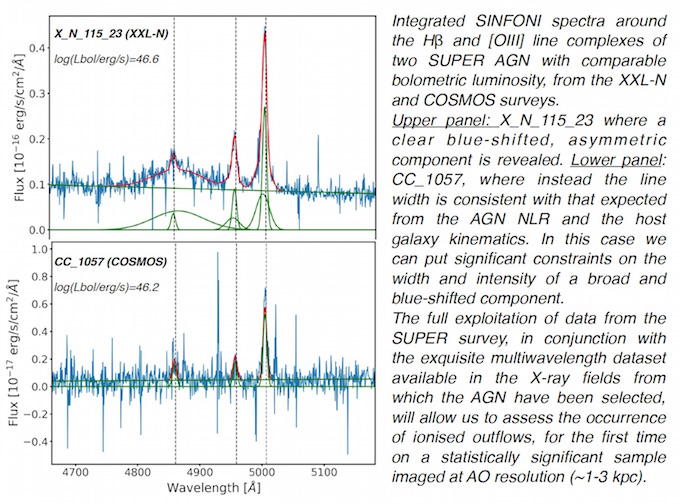WP2 is organised into two tasks and based on data from the programs in the Figure below
The SUPER VLT Large program is the first statistically sound sample at z~2 which is used to map the ionized gas kinematics of the host galaxies at resolution of ~1-3 kpc, made possible by the use of AO techniques.
Task2.1 The SUPER SINFONI LP to map AGN driven winds [Lead: UniFi, participants: INAF, UniBo]
We will use spatially resolved near infrared spectroscopy to:
1) Map the ionized gas phase traced by [O III] lines at ~few kpc scales [34,32].
2) Map the spatial distribution of the narrow component of Ha, to verify if the SF is heavily suppressed in the regions with the strongest velocity components[35,36].
3) probe ionized winds down to a mass outflow rate of tens of MSun/yr, a factor ~10 lower than expected by the scaling relations in [24]. The following figure shows two examples of wind clear detection and non-detection
Task-2.2 Probing the effect of BH winds on host galaxies gas reservoirs [Lead: UniBo: participants: INAF, UniFi]
We will use the SUPER-ALMA data, in conjunction with exquisite multiwavelength information, to:
1) Explore the AGN impact on host galaxies gas reservoir by measuring gas fraction and molecular gas tdep.
2) In the cases where molecular outflows are detected via spatially resolved imaging or asymmetric line profiles, we will investigate the multi-phase conditions of the outflowing gas. 3) Compare our observations with wind properties in zoom-in simulations that use different AGN feedback physics (WP4).
Altogether, we will compute BH wind physical parameters, and search for trends with the AGN properties and galaxy SFR, and gas mass, as done in F17, but for the first time for a homogeneous and unbiased sample, and including the direct and/or indirect information of their positive/negative effects on the host galaxy gas reservoirs.


